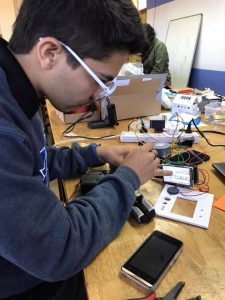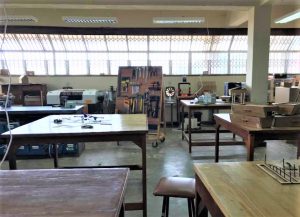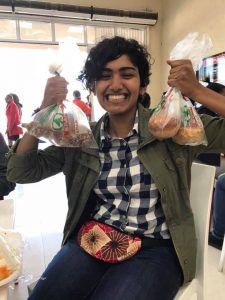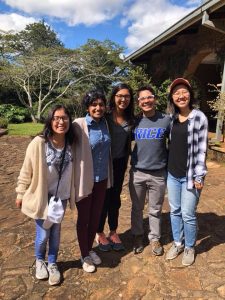Day 1:
Hi! We are finally in Malawi! We arrived at the Malawi airport Wednesday evening where we met Francisco, who gave us all big hugs as if we’ve met before. It was actually such a touching scene. Francisco is a general surgeon at Queen Elizabeth Hospital who is currently doing research on rotavirus in the city. He and Enock, another doctor at Queens, drove us thirty minutes to Kabula Lodge. The drive was amazing. There were people walking up and down the roads, bustling markets, and kids running back home after school. Everything is so lively and colorful here. By the time we got to our new home, it was pitch black (since it’s winter, it gets dark at 5:30 so it feels like the day goes by so quickly). The view of the mountains from our place is really breathtaking. I don’t think I will ever get over it. Every time I see the view, I’m always amazed 
Day 2:
The next morning, we visited the Rice 360 office and were greeted by the Malawian staff working there. We walked over to Queens next door and met Prince, a licensed nurse who also works for Rice 360. Prince gave us a tour of the neonatal ward and the stark differences between their hospital and what we are familiar with is unbelievable.
The ward can house about 60 infants, divided into high-risk, medium-risk, and low-risk. These babies were premature and had so many different complications as a result. There are only 6 or so nurses in the ward during the day, making it very difficult to monitor all the infants. At night, there are even fewer nurses on duty (2 or 3). And during this time, many babies die because of the lack of constant monitoring.
We saw some wooden boxes side by side down the middle of the ward, which were called hot cots. These cots consist of a bulb and some basic electrical components which, when turned on, quickly heats the boxes and acts as make-shift incubators for the infants. The babies were so helpless, nestled in the hot cots with the warm glow of the light over them. Prince told us that these boxes were dangerous because the bulbs often overheat and shatter. The boxes themselves were also extremely unstable. I thought some of theme were going to break when touched. However, these boxes are still used by the staff because they are simple, can be easily fixed when broken, and can be made quickly in large quantities, making them the preferred choice to despite the perfectly functioning incubator that was collecting dust in the corner of the ward. None of the nurses knew how to use this incubator and preferred the unsafe hot cots instead. This really showed me how important it is that the medical devices given to the hospitals are simple to use and simple to troubleshoot, otherwise the staff will continue to use a more basic and less effective alternative.
Prince pointed out the heating lamps lining the walls above the infant beds. He laughed as he told us that the nurses turned on the lamps when they felt cold and turned off the lamps when they felt hot. There wasn’t a way to find the ideal temperature in the ward for the infants, and there is no way to adjust the temperature.
Prince showed us his office and we saw some vials with serum samples in a test rack and a small spectrometer in the corner. He told us that he is technically on vacation, but he is still working at the hospital because he is the only staff member who is able to test the infants for jaundice by analyzing bilirubin levels in their blood. There are so many infants that come to the hospital on a daily basis, and along with his other duties he has to test every single one of them for jaundice. It’s incredible.
We left the hospital with so much information, despite this being our very first visit. We realized that there were so many different directions we can focus our attention on:
- We can improve the hot cots so that they are safer for the infants but still easy to use for the nurses.
- The ambient temperature in the ward can be analyzed and a temperature monitoring and controlling system can be made so that the heating lamps are not turned on and off arbitrarily by the nurses.
- There are only a couple of monitors for the babies that measure oxygen levels, heart rate, and temperature. These monitors are also only temporary, because they are part of an ongoing project and will be taken away in a couple of weeks. Simple monitors can be made for all the infants in the ward to make up for the lack of nurses.
These are just some of the ideas we came up with. I’m sure that we will come up with many more as we continue to speak to the nurses and hospital staff at Queens. I’m looking forward to speaking with Prince again because he is so insightful and knowledgeable. He was very straight forward about what the hospital needs, what was lacking, and what we as interns could focus on for our future projects.
Day 3:
The next day, (after a VERY long period of getting kicked off one bus because it wasn’t our ride and waiting another hour for our actual bus) we went to the Polytechnic school, which is about a ten minute walk from Queens. I was second-hand stressed because the students are currently studying for their finals (for a second, I panicked and asked myself if I have things I should be studying for too). Francis and Andrew (our Malawian mentors at Poly) gave us access to the engineering design studio so we could work on our devices that we brought from Rice.
I definitely found my home in that studio. The windows were all open so it was pretty chilly, but the workspace was awesome. They had everything we had back in our OEDK, including a laser cutter and multiple 3D printers. I could spend hours and hours just working on projects there. I love the space.
Also, across the street there are some amazing shops and places to eat. So far, our favorite place to eat is Spar and they have some AWESOME pastries.
I’m excited (and a little anxious) about presenting our devices this Monday to our Dean of Engineering, a US Aid, and faculty of Rice 360. But I am excited to be getting feedback and showcasing the models that we have tirelessly been working on. After next week, we will finally get to meet our Malawian interns and I cannot wait! I know they will have so much information and knowledge about problems being dealt with here. I’m excited to see what insight they will bring!
Day 4
We spent today exploring! We met Edson, an awesome driver (and even better photographer as we found out). He took us to try some amazing Malawian tea at Satemwa (about an hour drive away from Blantyre), and it was so good. I hate tea, but I bought so much!
He took us to a local Malawian restaurant that he always eats at and the food was so good (and so filling I ate way too much). We then went to a market and bought a few things so we can do our laundry (and adventure on it’s own, I just spent four hours getting drenched and washing my clothes).



